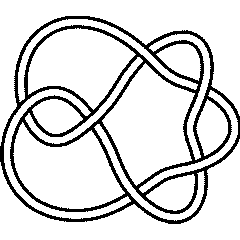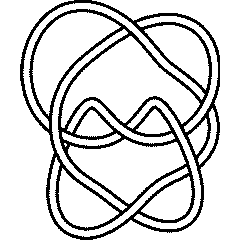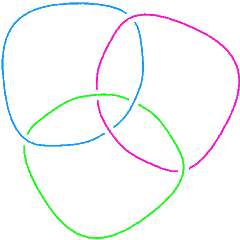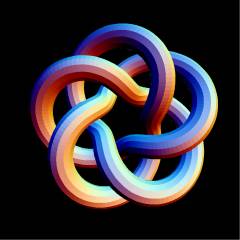KnotTheory` comes loaded with some knot tables; currently, the Rolfsen table of prime knots with up to 10 crossings [Rolfsen], the Hoste-Thistlethwaite tables of prime knots with up to 16 crossings and the Thistlethwaite table of prime links with up to 11 crossings (see Knotscape):
(For In[1] see Setup)
| In[2]:=
|
?Knot
|
| Knot[n, k] denotes the kth knot with n crossings in the Rolfsen table. Knot[11, Alternating, k] denotes the kth alternating 11-crossing knot in the Hoste-Thistlethwaite table. Knot[11, NonAlternating, k] denotes the kth non alternating 11-crossing knot in the Hoste-Thistlethwaite table.
|
|
| In[3]:=
|
?Link
|
| Link[n, Alternating, k] denotes the kth alternating n-crossing link in the Thistlethwaite table. Link[n, NonAlternating, k] denotes the kth non alternating n-crossing link in the Thistlethwaite table.
|
|
Thus, for example, let us verify that the knots 6_1 and 9_46 have the same Alexander polynomial:
In[4]:=
|
Alexander[Knot[6, 1]][t]
|
Out[4]=
|
2
5 - - - 2 t
t
|
In[5]:=
|
Alexander[Knot[9, 46]][t]
|
Out[5]=
|
2
5 - - - 2 t
t
|
We can also check that the Borromean rings, L6a4 in the Thistlethwaite table, is a 3-component link:
In[6]:=
|
Length[Skeleton[Link[6, Alternating, 4]]]
|
Out[6]=
|
3
|
| In[7]:=
|
?AllKnots
|
| AllKnots[] return a list of all the named knots known to KnotTheory.m.
|
|
| In[8]:=
|
?AllLinks
|
| AllLinks[] return a list of all the named links known to KnotTheory.m.
|
|
Thus at the moment there are 802 knots and 1424 links known to KnotTheory`:
In[9]:=
|
Length /@ {AllKnots[], AllLinks[]}
|
Out[9]=
|
{802, 1424}
|
In[10]:=
|
Show[DrawPD[Knot[13, NonAlternating, 5016], {Gap -> 0.025}]]
|
|
|

|
Out[10]=
|
-Graphics-
|
(Shumakovitch had noticed that this nice knot has interesting Khovanov homology; see [Shumakovitch]).
In addition to the tables, KnotTheory` also knows about torus knots:
| In[11]:=
|
?TorusKnot
|
| TorusKnot[m, n] represents the (m,n) torus knot.
|
|
For example, the torus knots T(5,3) and T(3,5) have different presentations with different numbers of crossings, but they are in fact isotopic, and hence they have the same invariants (and in particular the same type 3 Vassiliev invariant  ):
):
In[12]:=
|
Crossings /@ {TorusKnot[5,3], TorusKnot[3, 5]}
|
Out[12]=
|
{10, 12}
|
In[13]:=
|
Vassiliev[3] /@ {TorusKnot[5,3], TorusKnot[3, 5]}
|
Out[13]=
|
{20, 20}
|
KnotTheory` knows how to plot torus knots; see Drawing with TubePlot.
References
[Rolfsen] ^ D. Rolfsen, Knots and Links, Publish or Perish, Mathematics Lecture Series 7, Wilmington 1976.
[Shumakovitch] ^ A. Shumakovitch, Torsion of the Khovanov Homology, arXiv:math.GT/0405474.





